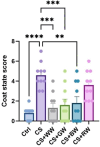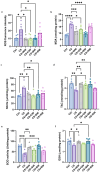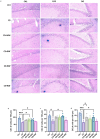Modulating depressive-like behaviors, memory impairment, and oxidative stress in chronic stress rat model using visible light therapy
- PMID: 40676115
- PMCID: PMC12271371
- DOI: 10.1038/s41598-025-10854-w
Modulating depressive-like behaviors, memory impairment, and oxidative stress in chronic stress rat model using visible light therapy
Abstract
Chronic stress has been linked to significant cognitive impairments, which are exacerbated by oxidative stress and neuronal damage in brain regions such as the hippocampus and prefrontal cortex. This study investigates the therapeutic effects of different visible light wavelengths (white, red, green, and blue) on cognitive dysfunction and oxidative stress in a chronic unpredictable mild stress (CUMS)-induced rat model using stressors such as cold-water swimming, tail pinching, food and water deprivation, cage tilting, shaking, continuous illumination, wet cages, heat stress, and restraint. Sixty male Wistar rats were divided into control, CUMS, and light-exposure groups. The light-exposed groups received daily exposure to white (3000 lx), red (650 nm, 1300 lx), green (530 nm, 1300 lx), or blue (460 nm, 1300 lx) light for four hours over four weeks. Behavioral assessments were conducted to evaluate memory and depression-like behaviors. Biochemical analyses were performed to measure oxidative stress markers, acetylcholinesterase (AChE) activity, and serum corticosterone levels. Results showed that chronic stress significantly impaired cognitive function, increased oxidative stress, elevated AChE activity, and serum corticosterone level. Red light exposure had no significant effect on any of the evaluated parameters. However, Light exposure, particularly blue light, mitigated these effects by reducing reactive oxygen species (ROS), malondialdehyde (MDA), and nitrite levels, while enhancing total antioxidant capacity (TAC), superoxide dismutase (SOD) activity, and glutathione (GSH). Behavioral outcomes also improved, with increased memory performance and reduced depressive behaviors in light-treated groups. Histological analyses revealed decreased neuronal damage in the hippocampus and prefrontal cortex following light therapy. These findings suggest that visible light exposure, especially blue light, may serve as a promising non-invasive intervention for stress-induced cognitive impairments by reducing oxidative stress and neuronal damage.
Keywords: CUMS; Chronic stress; Cognitive function; Light wavelengths; Oxidative stress.
© 2025. The Author(s).
Conflict of interest statement
Declarations. Competing interests: The authors declare no competing interests.
Figures












References
-
- Kültz, D. Defining biological stress and stress responses based on principles of physics. J. Exp. Zool. Ecol. Integr. Physiol.333, 350–358. 10.1002/jez.2340 (2020). - PubMed
-
- Yamamoto, S. et al. Effects of single prolonged stress and D-Cycloserine on contextual fear extinction and hippocampal NMDA receptor expression in a rat model of PTSD. Neuropsychopharmacology33, 2108–2116. 10.1038/sj.npp.1301605 (2008). - PubMed
-
- Prajapati, S. K., Singh, N., Garabadu, D. & Krishnamurthy, S. A novel stress re-stress model: Modification of re-stressor cue induces long-lasting post-traumatic stress disorder-like symptoms in rats. Int. J. Neurosci.130, 941–952. 10.1080/00207454.2019.1711078 (2020). - PubMed
MeSH terms
Substances
Grants and funding
LinkOut - more resources
Full Text Sources
Medical

